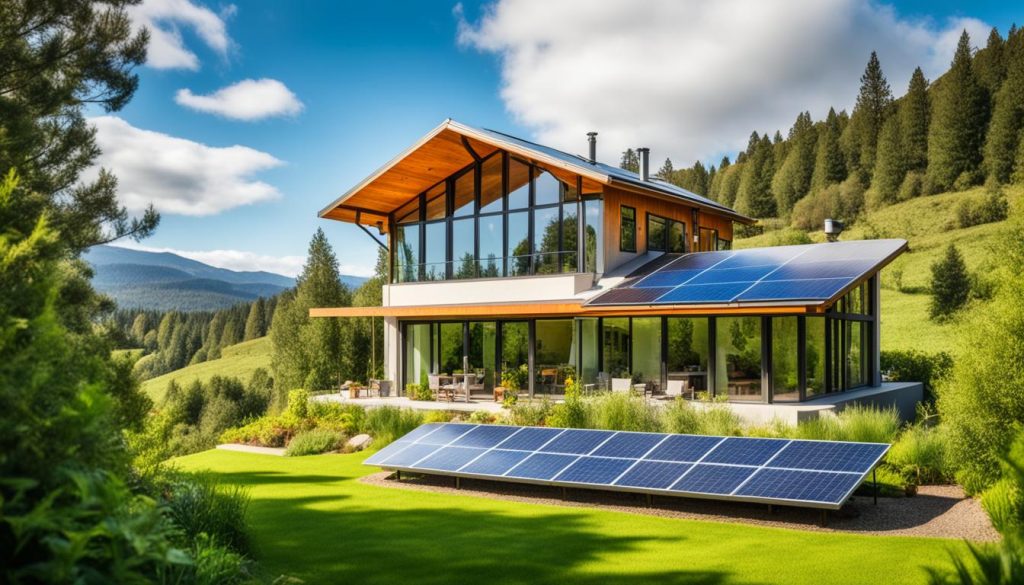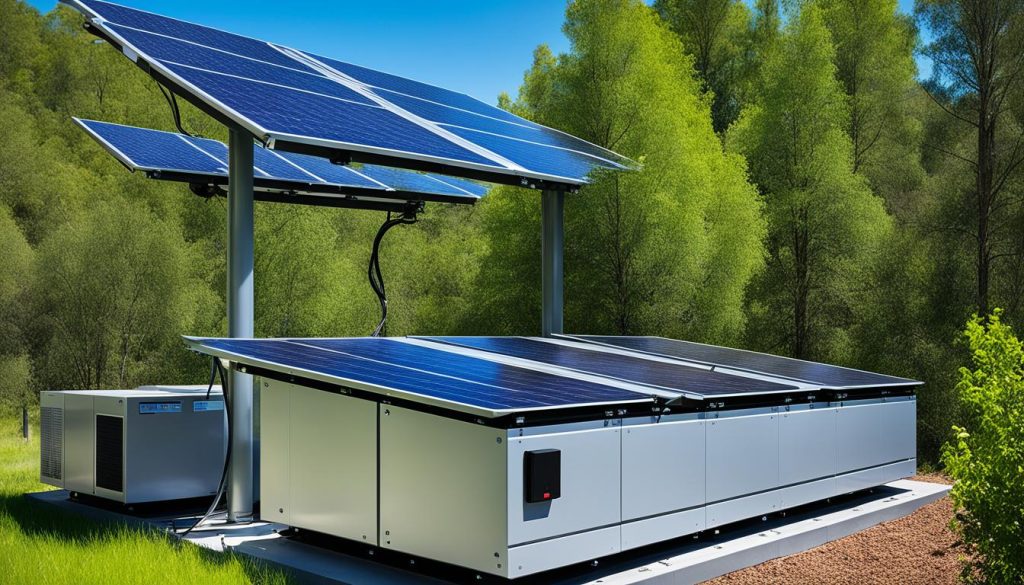Off-grid living can cut your need for regular power and help the planet. Choosing to be more energy efficient is a wise and green move. It lets us live a more self-sufficient life and enjoy living off the grid.
Off-grid life needs smart planning to save energy. Passive design can make your home comfortable without extra heat or AC. It means facing your house the right way, using insulation, and letting natural breezes in.
Where you put rooms inside your home matters too. For the best energy use, put living areas north and utility spaces west. This uses the sun’s warmth well and keeps your home from getting too hot or cold.
Think about the outside too. Shade from trees or awnings can cool your home naturally. And choose energy-saving tools and lights. This cuts your use of power and makes your lifestyle more green.
Key Takeaways:
- Passive design techniques, such as proper orientation, insulation, and natural ventilation, help maintain a consistent temperature inside the house.
- Internal planning, including placing high-use areas on the Northern side and utility rooms on the Western side, enhances energy efficiency off-grid.
- Landscaping, shading, and the use of energy-efficient appliances contribute to reducing energy consumption and maximizing sustainability.
- Off-grid living reduces reliance on traditional power sources and promotes a more sustainable future.
Passive Design for Energy Efficiency Off-Grid
Energy efficiency off-grid is key, and passive design helps a lot. It uses natural climate and surroundings to keep indoor spaces comfortable. This eliminates the need for regular heating or cooling. Passive design also cuts down on energy use and boosts system sustainability.
House placement and orientation are crucial for passive design. They utilize the warm winter sun and avoid the hot summer sun. This setup regulates indoor temperatures well, reducing the need for any extra heating or cooling.
Insulating ceilings and walls keeps the inside temperature steady. Good insulation acts as a barrier against temperature changes, making living spaces more comfortable. High-quality insulation is a must for passive design and energy efficiency off-grid.
Using the sun and thermal mass for heating is another key point. Placing windows or skylights to catch the sun’s warmth in winter is smart. Also, adding thermal mass materials like concrete or stone to the house holds heat, keeping rooms warm at night.
Protecting the house from the summer sun is just as critical. Shading with trees or structures keeps the interior cool, reducing the need for cooling. Overhangs, awnings, or special window coverings also help by keeping direct sunlight out.
Good airflow and ventilation are essential for a successful passive design in off-grid living. Features like well-placed windows and vents aid in cross-ventilation and air exchange. They keep the indoor air fresh and prevent it from becoming too humid or stuffy.
By using these passive design methods, off-grid living can be both pleasant and eco-friendly. It aims to rely less on energy-hungry devices and to work with nature’s resources. This approach supports a sustainable way of life.
Example of a Passive Design for Off-Grid Energy Efficiency
| Feature | Description |
|---|---|
| Orienting the House | The house is positioned to take advantage of the winter sun’s warmth while minimizing direct exposure to the summer sun’s heat. |
| Insulation | The ceilings and walls are heavily insulated to prevent thermal exchange and maintain a consistent temperature. |
| Winter Sun and Thermal Mass | Windows and skylights are strategically placed to capture the sun’s rays, while thermal mass materials absorb and store heat for gradual release. |
| Shading | Natural vegetation, roof overhangs, or window treatments are utilized to shade the house from the summer sun and minimize heat gain. |
| Airflow and Ventilation | Well-placed windows, vents, or natural ventilation systems facilitate cross-ventilation and ensure fresh, circulating air. |
Renewable Energy Sources for Off-Grid Living
Using renewable energy is key for off-grid living. It lets off-grid folks rely less on the usual power sources. Solar power and wind energy are two top choices for those going off the grid.
Solar power comes from solar panels. These panels soak up the sun’s energy and turn it into power. You can put them on a roof or in a sunny spot. This way, they catch the most light. The power from solar panels runs things like appliances and lights in off-grid houses. It’s important to buy top-notch panels and look after them well. This makes them work better and last longer.
Wind energy works through wind turbines. These turbines use the wind to create electricity. They’re set up in breezy areas. Here, they change the wind’s force into electric power. This power is saved in batteries for when it’s needed. It’s vital to pick the right spot for turbines. This ensures they catch as much wind as possible.
Choosing good solar panels and batteries is a must for off-grid living. They’re crucial for a reliable energy system. Also, using appliances and lights that save energy is smart. It cuts down on power use and helps the planet. Plus, it saves money on energy bills over time.
Below is a table showing how solar power and wind energy compare:
| Renewable Energy Source | Advantages | Limitations |
|---|---|---|
| Solar Power | – Abundant sunlight | – Dependency on weather conditions |
| Wind Energy | – Continuous source of wind | – Space and location requirements |
Looking at the table helps to see what each energy source offers. This can help people decide what’s best for their off-grid energy needs.

In the end, turning to solar and wind power is key for living off the grid. By getting quality gear, using energy-saving devices, and being mindful of energy use, a sustainable life off the grid is possible.
Battery Storage Systems for Off-Grid Energy
Battery storage systems are key for off-grid power. They store energy from solar panels or wind turbines. So, you have power even without the sun or wind. This makes your power supply steady and reliable.
There are many battery systems for off-grid living. Now, we will look at the most liked ones:
DC Battery Systems
DC batteries are affordable and easy to set up. They store direct current (DC) electricity. This power runs your home’s devices. One downside is they can be less efficient in how they charge and discharge.
AC Battery Systems
AC batteries are often used off-grid. They store and provide alternating current (AC) power, like the grid. This lets you use grid power as a backup. They offer a flexible and dependable power solution off the grid.
Hybrid Battery Systems
Hybrid batteries offer the benefits of both DC and AC. They seamlessly switch between DC and AC power. These batteries are flexible and reliable, making them a great pick for off-grid power storage.
“Battery storage systems are the backbone of off-grid power solutions, ensuring a constant and clean energy supply.”
BigBattery is known for their top-quality off-grid batteries. They offer many sizes to fit your power needs, from 5.12kWh to 43kWh. Made in the USA, these batteries are praised for their performance and dependability.
Compared to lead-acid batteries, BigBattery’s lithium-ion batteries store 50% more energy. This means longer power backups for off-grid living. They give users the exact capacity they need, helping achieve energy independence.
“BigBattery’s off-grid solar batteries are not only powerful but also the safest energy source for solar applications.”
BigBattery’s batteries come with a 10-year warranty. They also have full battery coverage for peace of mind. Plus, free shipping on some modules helps make safe and reliable energy easier to get for off-grid users.
BigBattery’s systems offer top performance, lasting warranty, and safety. They’re perfect for those aiming to improve their off-grid energy use and reach energy independence for good.

Conclusion
Choosing energy efficiency off-grid is smart for those wanting a greener life. With smart planning and passive designs, you can use less energy. Solar power and wind help you rely less on normal power. This makes your life more sustainable.
To keep your off-grid systems working well, always check and maintain them. Online tools and apps let you check your systems live. They help fix issues before they get big. Adding efficient energy storage, like lithium-ion batteries, keeps your energy supply steady.
Biomass and wind offer great ways to make your own electricity, heat, or fuel. Knowing about different turbines and setups helps you use wind power well. By putting different green energy systems together, you make your off-grid power supply more reliable. You can tailor it to your place’s needs.
Be sure to use efficient insulation, appliances, and solar designs to lower how much energy you use. This is key for off-grid living. It helps your systems work better and saves energy. By doing this, you’re on your way to a sustainable off-grid life.
